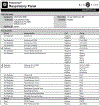Collection of SARS-CoV-2 Virus from the Air of a Clinic Within a University Student Health Care Center and Analyses of the Viral Genomic Sequence
- PMID: 33424954
- PMCID: PMC7792982
- DOI: 10.4209/aaqr.2020.02.0202
Collection of SARS-CoV-2 Virus from the Air of a Clinic Within a University Student Health Care Center and Analyses of the Viral Genomic Sequence
Abstract
The progression of COVID-19 worldwide can be tracked by identifying mutations within the genomic sequence of SARS-CoV-2 that occur as a function of time. Such efforts currently rely on sequencing the genome of SARS-CoV-2 in patient specimens (direct sequencing) or of virus isolated from patient specimens in cell cultures. A pilot SARS-CoV-2 air sampling study conducted at a clinic within a university student health care center detected the virus vRNA, with an estimated concentration of 0.87 virus genomes L-1 air. To determine whether the virus detected was viable ('live'), attempts were made to isolate the virus in cell cultures. Virus-induced cytopathic effects (CPE) were observed within two days post-inoculation of Vero E6 cells with collection media from air samples; however, rtRT-PCR tests for SARS-CoV-2 vRNA from cell culture were negative. Instead, three other fast-growing human respiratory viruses were isolated and subsequently identified, illustrating the challenge in isolating SARS-CoV-2 when multiple viruses are present in a test sample. The complete SAR-CoV-2 genomic sequence was nevertheless determined by Sanger sequencing and most closely resembles SARS-CoV-2 genomes previously described in Georgia, USA. Results of this study illustrate the feasibility of tracking progression of the COVID-19 pandemic using environmental aerosol samples instead of human specimens. Collection of a positive sample from a distance more than 2 m away from the nearest patient traffic implies the virus was in an aerosol.
Keywords: COVID-19; aerosol; air sampling.
Figures



References
-
- Chia PY, Coleman KK, Tan YK, Ong SWX, Gum M, Lau SK, Sutjipto S, Lee PH, Son TT, Young BE, Milton DK, Gray GC, Schuster S, Barkham T, De PP, Vasoo S, Chan M, Ang BSP, Tan BH, Leo YS, Ng O-T, Wong MSY and Marimuthu K (2020). Detection of Air and Surface Contamination by Severe Acute Respiratory Syndrome Coronavirus 2 (SARS-CoV-2) in Hospital Rooms of Infected Patients. medRxiv: 2020.2003.2029.20046557. - PubMed
-
- Hadei M, Hopke PK, Jonidi A and Shahsavani A (2020). A Letter About the Airborne Transmission of SARS-CoV-2 Based on the Current Evidence. Aerosol Air Qual. Res 20: 911–914.
-
- Hogan CJJ, Kettleson EM, Lee MH, Ramaswami B, Angenent LT and Biswas P (2005). Sampling Methodologies and Dosage Assessment Techniques for Submicrometer and Ultrafine Virus Aerosol Particles. J. Appl. Microb 99: 1422–1434. - PubMed
Grants and funding
LinkOut - more resources
Full Text Sources
Research Materials
Miscellaneous
